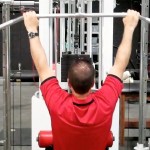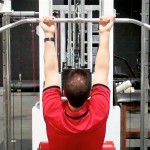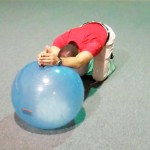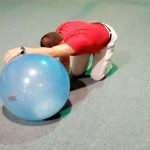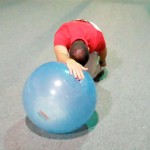Brian Schiff’s Blog
Injury Prevention, Sports Rehab & Performance Training Expert
I am big fan of lat pull downs and pull-ups. I think when done properly, this is a fantastic way to improve postural strength and safeguard the shoulder against injury. In April 2012, I wrote a column on lat pull downs addressing shoulder pain (click here to read that post).
I decided to add to that previous post and discuss a recent article published in the February NSCA Strength and Conditioning Journal. In the article, the authors present some research regarding how altering hand orientation and grip width affects muscle activity during the exercise.
Grip Width Summary
Lehman J Strength Cond Res 2005
- No significant difference between narrow supinated grip and wide pronated grip with biceps and latissimus dorsi
- Highest level of latissimus dorsi activity occurs with seated row with retracted shoulders
Lusk et al. J Strength Cond Res 2010
- No difference in biceps, latissimus or middle trapezius activity (note – wide grip only slightly larger than narrow grip)
Sperandei et al. J Strength Cond Res 2009
- In front of the head pull downs with standardized width and hand orientation revealed higher activation for posterior deltoid and latissimus compared to behind the neck
- This study did NOT compare different grip widths
Hand Orientation Summary
Youdas et al.J Strength Cond Res 2010
- Pronated grip during pull-ups (56 +/- 21% MVIC) was most effective for activating the lower trapezius compared with the supinated grip
- Pronated grip also resulted in greater infraspinatus activation (45 +/- 22% MVIC) compared with the perfect pull-up
- Perfect pull-up showed higher latissimus activity (130 +/- 53% MVIC) than the supinated grip of a chin up
- Supinated grip of the chin-up revealed an increase in pec major (57 +/- 36% MVIC) and biceps brachii (96 +/- 34% MVIC) versus 44 +/- 27% (pec major) and 78 +/- 32% (biceps brachii) for the pronated version
- Posterior deltoid showed no difference in all hand orientations
Lusk et al. J Strength Cond Res 2005
- Pronated grip during lat pull-downs elicited a 9% greater muscle activation of latissimus dorsi compared to supinated grip
- No difference between middle trapezius and biceps brachii in pronated or supinated grip
My Takeaways
- If your goal is maximizing latissimus activity and improving scapular stabilizer and rotator cuff function opt for the pronated grip
- Supinated grip elicits greater activation in the pectoralis major and biceps – no surprise here based on physics and kinesiology -> easier for clients to do and also not going to stress the shoulder as much in the presence of any inflammation or pathology
- Range of motion, scapular dyskinesia, pain, soft tissue restrictions and imbalances play a vital role for each client so they may need some preparatory work to make the most of this exercise
- Small tweaks (in my opinion) can make a big difference in comfort level and performance of the exercise (refer to number 3 for why) so do not be afraid to experiment between wide and narrow in a pronated grip
- The authors mention that if individuals elect to do the behind the neck version they should have adequate range of motion to do it safely. Let me be clear – there is NO reward big enough to justify the risk involved in doing behind the neck pull-downs. Save your neck and shoulders by eliminating this option altogether as I would bet most of us do not have perfect bony anatomy, mobility and optimal muscle firing throughout the motion to ensure that potential repetitive micro trauma will not occur over time.
For my CrossFit friends – optimal shoulder mobility, scapular stability and adequate thoracic spine extension and rotation is a must to minimize risk with kipping and less than perfect pulling form. I much prefer unweighting or assisting the body through pull downs, bands or partner assists to build pre-requesite strength initially until the client is better able to manage the movement under full body weight.
Quality movement ABSOLUTELY matters over hundreds and thousands of reps.
As far as research goes, I think we still need further studies on grip width and specifically how it may directly impact not only muscle activation but force on the glenohumeral joint itself. For me, I opt for pronated pull-ups and or pull-downs once per week with a moderate grip width in my own routine. I hope this information serves you well. Happy lat training!!
Working with athletes of many disciplines affords me an opportunity to look at many shoulders week to week. Increasingly, I am seeing more Crossfit athletes for various shoulder problems. In many cases, they have rotator cuff tendonitis, impingement, AC joint pain, labral pathology or a combination of the aforementioned issues. The other big group of athletes I see is throwers.
These two groups share many of the same dysfunctions including posterior shoulder tightness and decreased mobility. Tightness in the pecs and lats is commonplace. I feel latissimus tightness often goes unnoticed or perhaps is not an area of emphasis in prehab/rehab plans. Tight lats will restrict elevation and contribute to postural dysfunction.
With restricted elevation, athletes may turn to excessive spinal extension and/or rotation to achieve elevation necessary (e.g. overhead squats, snatches, throwing) and this can contribute to poor movement patterns. I have also seen this impact volleyball players asymmetrically with serving and hitting.
Lat tightness can easily be assessed by placing the athlete supine and simply asking them to bring the arms completely overhead. While most people do not have 180 degrees of flexion, I feel working to achieve elevation greater than or equal to 160 is completely reasonable. The body often uses abduction and external rotation to make things work (and this is natural for throwers), but the more pure elevation capacity we have the the better.
Crossfit involves lots of pull-ups and throwing heavily utilizes the pecs and lats for acceleration. It only follows that muscular tightness in this region may need to be addressed. Step one often involves soft tissue mobilization/compression techniques. I prefer to use a Trigger Point ball or Grid to work on the soft tissue mobilizing it on the wall (TP ball) or floor (Grid) in an elevated position.
Next, I like to employ active mobility work. I recently featured a simple exercise using the BOSU Ballast Ball in my PFP column. The pictures below reveal a rolling double arm version, as well as a single arm method/progression. These active movements can also be complimented by sustained holds as desired.
For a more detailed description and application of this exercise, click here to read my “Functionally Fit” column. I had one Crossfit enthusiast see me for limited shoulder mobility as it was hindering his overhead lifts and causing back pain. He had about 130 degrees of shoulder flexion. Daily STM using the foam roller, mobility work and some stretching increased his elevation by 10 degrees in 2-3 short weeks.
So, the take home message is that overhead athletes should assess and address this limitation if it is present as it may cause kinetic chain issues and energy leaks. Improving mobility will better enable utilization of proper muscle activation and optimal movement patterns.
Below are two videos demonstrating some sliding exercises I like to use in training and rehab. The first video reveals one of my tougher hamstring exercises I prescribe, while the second video displays some shoulder/core stability variations using sliding discs. I have included links to the PFP columns that better explain the set-up, execution and application for each exercise.
Click here for the Functionally Fit Column on sliding hamstring curls.
Click here for the Functionally Fit column on sliding shoulder raises.
As a therapist and fitness enthusiast, I always want to know the “why” and implications for exercises. I have posted on modified push-ups in the past, but I felt compelled to share some information that was published in the October 2012 Strength and Conditioning Journal. Bret Contreras et al. discuss the biomechanics of the push-up and provide an excellent overview of the different types of push-ups and what research has to say about them.

I was most interested by the parts on unstable push-ups as I tend to use the BOSU Balance Trainer and BOSU Ballast Ball in many of my programs. Here are some key points that the authors point out that are worth mentioning:
- BOSU push-ups have been shown to increase activity of some of the scapular stabilizers namely upper, middle and lower trapezius fibers compared to standard push-ups, while serratus anterior activity is diminished (Tucker et al. Arch Phys Med Rehabil 2010)
- Lehman et al. (Man Ther 2008) reported that elevating the feet above the hands had a greater stimulus on scapulothoracic stabilizing musculature than placing the hands on an unstable surface
- Lehman et al. (Dyn Med 2006) found that push-ups w/hands on a stability ball significantly increased the triceps brachii activation as well as invoking increased activation of pec major, rectus abdominus and external obliques compared with push-ups on a bench from the same angle. However, note that feet on the stability ball did not affect muscle activity compared to push-ups with feet on a bench at the same angle
- According to Marshall and Murphy (Apply Physiol Nutr Metab 2006) triceps brachii and abdominal EMG activity was much greater when performing push-ups off a stability ball compared to stable surfaces from flat and elevated positions
Takeaways:
- Using unstable surfaces for push-ups when the primary base of support is the stability ball, BOSU, or BOSU Ballast Ball is more effective in increasing muscle activation of aforementioned muscles
- Placing the feet on an unstable surface does not add much benefit in terms of increasing muscle activation
- Maintaining a stable torso and spine angle is key and should not be compromised with an unstable surface
Other thoughts of mine:
Mastering form, alignment and strength with stable push-ups is common sense, right? So, do not advance to unstable push-ups without pre-requisite strength and satisfactory technique in a stable environment. Wrist mobility, shoulder stability, and core strength are just a few other key factors that should weigh in your decision to implement unstable push-ups.
Considering some isometric work with slightly bent elbows or even some small pulses can be effective in progressing toward these more advanced unstable push-ups. Clients need to understand the point of no return and I prefer to spot closely particularly when using a stability ball or BOSU Ballast Ball. Working with the BOSU (dome side down) is generally safer and allows for easier modification with the knees on the ground for those with less upper body strength or diminished control.
I also like to add a plus (scapular protraction at the top) to help counter the loss of serratus activity seen with BOSU push-ups. In the end, I really like using the unstable surface as the point of balance and have for some time. There are many ways to do push-ups, but considering some unstable work has a good return for those clients whoa ready for it.
Below is a picture of the BOSU Ballast Ball – I prefer it over the stability ball as it is less likely to slip out from underneath the client. It provides excellent shoulder and core stability work – my primary goals when electing to use it. Reps, sets, progression and recovery will be dictated by fatigue and form at all times.

It is no secret that proper scapula alignment and muscle activation makes for a healthy shoulder. There are many forms of dysfunction that may be present.

Generally speaking problems revolve around muscular tightness/weakness and faulty movement patterns. The term “SICK” scapula is often used and refers to Scapula Inferior Coracoid Dyskinesis. Common examples of a “sick” scapula include:
- Type I – Inferior border prominence. This is typically related to tightness in the pec minor and weakness in the lower trapezius. Keep in mind the upper trapezius will naturally dominate the lower trap in the force couple with the serratus anterior for upward rotation. You may also see increased thoracic kyphosis which will inhibit the normal resting position of the scapula.
- Type II – Medial border prominence. In this case the scapula is internally rotated or protracted and there is liekly weakness present in the rhomboids and middle trapezius. The serratus anterior may also likely be weak with evidence of scapular winging. This position places the humerus in relative internal rotation and increases risk of impingement with arm elevation.
- Type III – Superior border presence. Here the scapula appears elevated in the face of an overactive upper trap and/or levator scapulae. With active arm elevation, you may notice excessive shrugging or superior humeral head migration in light of the imbalance. Again, the lower trapezius is probably weak and being overpowered.
Click here for a great graphic display from the Journal of the American Academy of Orthopaedic Surgeons of how the scapular muscles work collectively as a force couple to promote optimal movement in the shoulder.
In many of the throwers and overhead athletes I see in the clinic, they often exhibit either medial border prominence of inferior border prominence. Additionally, I frequently observe GIRD (glenohumeral internal rotation deficit) values of 20 degrees or higher in those patients who come in with symptomatic shoulders (rotator cuff and/or labral issues). What does this mean?
Well, in a nutshell, it means addressing posterior capsule tightness in the throwing shoulder is important for avoiding internal impingement and SLAP tears. Tightness (or too much GIRD) can increase the load/tension in the late cocking phase of throwing thereby contributing to friction between the cuff and labrum, as well as excessive torsion on the proximal biceps tendon. Any excessive humeral head migration with repetitive throwing is a recipe for injury over time.

